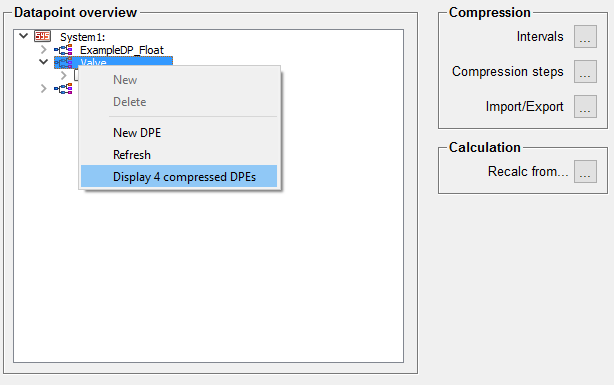Mass configuration of multiple data point elements
Mass configuration within the RDB compression means that compression calculations that have been added to a data point element at master data point can be taken over to these data point elements of all data points of the same data point type with only one click. Thereby the following has to apply:
-
The data point type must have a master data point.
-
Only data point elements, which are of the data type int, uint or float can be added to the RDB compression.
-
Only data point elements that have an archive PowerConfig at the master data point can be added to the RDB compression.
The mass configuration of multiple data point elements is described with the help of the following example.
 Mass configuration of multiple data points
Mass configuration of multiple data points
-
Create a new data point type named Valve with for example the following structure:
-
Add a master data point to the data point type.
-
Add to every data point element at the master data point an _archive PowerConfig.
-
Create for example the following three data points at the data point type:
-
Open the RDB compression (see Configuration - Introduction).
-
At the data point element _mp_Valve.Valve_1 to the tree view of the RDB compression (for the instruction how to add a new data point element to the tree view see Adding a data point element).
-
The tree view of the RDB compression has now the following the structure:
-
Add the two left data point elements to the tree view (_mp_Valve.Valve_2.Valve_2_1 and _mp_Valve.Valve_3.Valve_3_1.Valve_3_1_1).
-
The tree view of the RDB compression has now the following the structure:
-
Select the option "Display <number> compressed DPEs".

-
Right-click the master data point in the tree view to open the context menu:
-
Click the Take over for all option to take over all compression calculations at the data point elements for all data points of this data point type.
-
The 3 data points have been added to the tree view and have the same compression calculations at their data point elements created at the master data point before.
-
In the case that for specific data points at a master data point a compression calculation should not be carried out, its compression calculations have to be deactivated (see Activating/Deactivating compression calculations) and/or deleted afterwards (see Deleting compression calculations). Note that the tree view has to be refreshed (Refresh option from the context menu) in order that the changes are shown correctly.
Adding new compression calculations to the data point elements of the data points with a master data point is still possible. Attention should be paid to the fact that the option "Take over for all" overwrites all compression calculations of the data points' elements of the specific type. That means that compression calculations that are only available at the data point but not at the master data point will deleted or overwritten when using this option.



